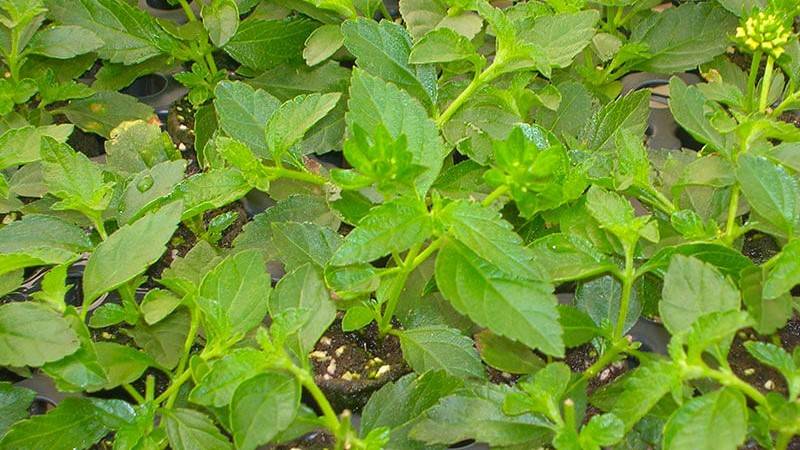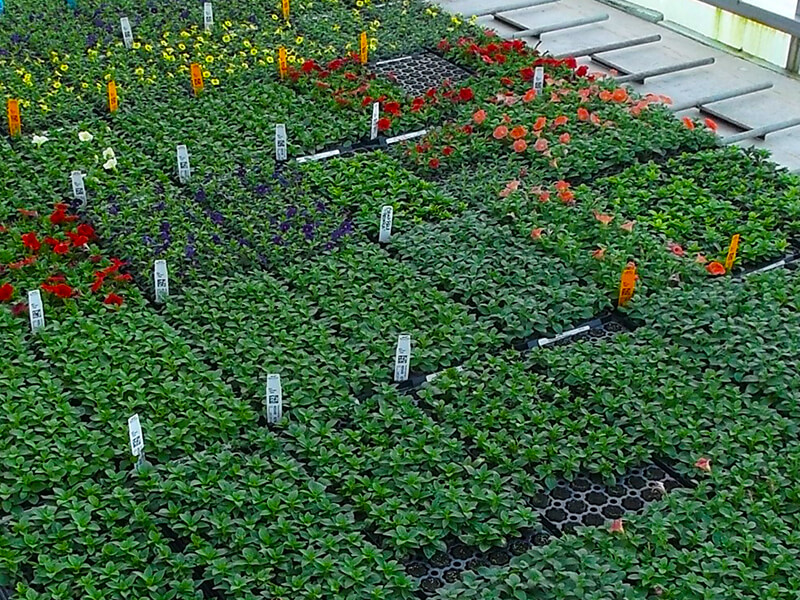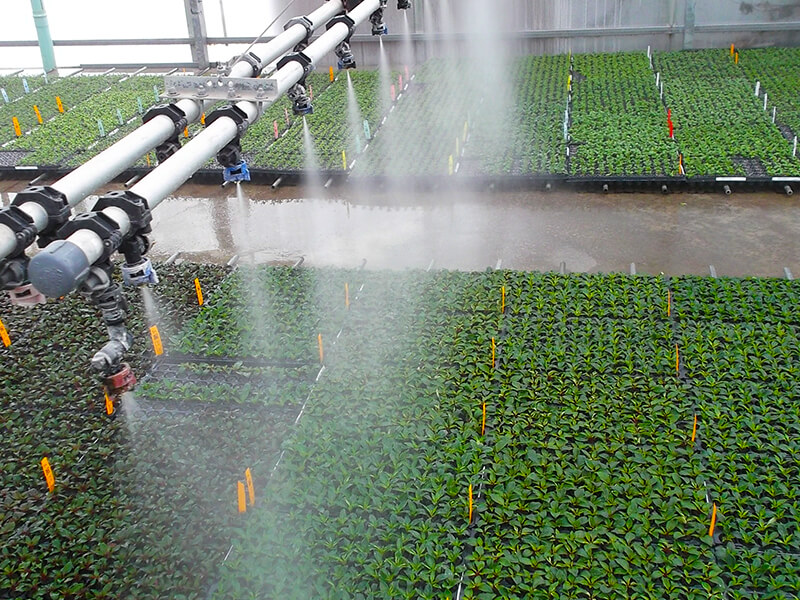Tips on Successful Young Plant Propagation


Most young plants are patent-protected, so growers are limited to what popular plant varieties they can propagate from cuttings. But for those who buy in unrooted cuttings to root for themselves or that serve as rooting stations for other growers, here are some helpful tips to produce quality rooted cuttings. In this article, we will focus on the general tips for propagation of most cuttings. Detailed information for each plant cultivar can be provided by your plant supplier or broker.
Cuttings
When you receive unrooted cuttings, they are ready to be stuck into the propagation media. Rooting for most cuttings occurs at the nodes, so the lower leaves are stripped from the cutting where the roots emerge. There are only a few leaves that remain on the unrooted cuttings because the leaves transpire water which can cause the cutting to lose turgidity (wilt) and possibly die. Cuttings should be stuck as soon as they arrive, but if this is not possible, store them cool, respecting temperature minimums for cold-intolerant plants.
Unrooted cutting propagation can take from 3-6 weeks for a finished liner. Typically, most plants are grown in larger celled, propagation trays, such as a 105 flat or larger. In propagation trays with smaller cells, for example 288’s, the cuttings are stuck much closer together so there can be increased loss from bacterial disease and often flowering is delayed in liners by a few days.
Growing Medium
A good growing medium should have good water-holding capacity and high air porosity. Many types of growing medium can work but misting/fogging needs to be adjusted to work with the growing medium selected. Too much or too frequent application of mist/fog keeps the growing medium saturated, excess water will flow from the bottom of the trays and rooting will be delayed. Applying mist/fog too infrequently will increase transpiration from the leaves and cuttings will lose turgidity and could die from drying out.
Ideally, the growing medium should contain peat to retain water and an aggregate like perlite or vermiculite to increase air porosity. PRO-MIX® substrates such as PRO-MIX® FPX AGTIV® STIMULATE™ are made from high-quality fibrous blonde Sphagnum peat and horticultural grade perlite, which contribute to air porosity and resist compaction. PRO-MIX FPX AGTIV STIMULATE also contains a wetting agent, lime, a low-solubility fertilizer that provides nutrients to plants, and the bacterium Bacillus, which enhances germination and rooting, helping to produce strong and healthy plants from the beginning of their growth.

Temperature
To improve success with rooting of cuttings it is best to maintain media temperatures between 68-77°F; even cold-tolerant crops such as pansy, dianthus, osteospermum, petunia, etc. prefer these media temperatures for rooting. Warm growing medium temperatures accelerate cell division which leads to faster callusing, root initial development and subsequent root growth. It also speeds up the dry-down rate of the growing medium, which also helps encourage better rooting. The best way to warm the growing medium is through bottom heat.
Air temperature is not as important for rooting, but it is suggested that it should be set between 65-75°F. Air temperature becomes important when new shoot growth begins; in that, warmer temperatures encourage faster top growth.
Once roots have grown to the bottom of the plug, growing medium temperatures can be reduced or plants can be taken off bottom heat systems. This will aid in the hardening process to help the plant get used to cold shipping and growing temperatures.
Misting / Watering
Mist or fog has to be applied often early in propagation to minimize transpiration so the cutting will not lose turgidity. Some growers will spray an adjuvant on the leaves of their cuttings to allow for uniform water coverage, slowing transpiration. The frequency of misting/fogging is often dictated by the growing medium and the needs of the cutting. The goal is to apply enough water to keep the growing medium wet, but not saturated. Closely monitor to determine the optimum duration and frequency of misting/fogging for each crop and for the time of year. Remember a wet environment invites disease that can rot cuttings or cause foliar diseases. Plants that are sensitive to excess misting (and more prone to disease) include begonia, bracteantha, heliotrope, verbena, etc.
Once cuttings start to callus, reduce mist/fog frequency and allow the growing medium to dry out more between irrigation events. Avoid saturating the growing medium as this will minimize oxygen in the growing medium which will stress the cuttings and inhibit root development. Plants that are sensitive to excess water and easily rot include begonia, bracteantha, calibrachoa, coleus, petunia, sutera, verbena, etc.
Once roots begin to develop, usually within 4-28 days, depending on the type of plant, remove the plant from mist/fog and bottom heat. Place them into the main area of the greenhouse where they are exposed to full light and lower humidity and allow the growing medium to dry between waterings to encourage root growth (the growing medium surface should turn light brown to tan between watering).

Fertilization
Determining if fertilizer should be applied to unrooted cuttings depends on the nutritional status of the stock plants from which the cuttings were taken. According to research by Santos et. al. (2008), if the stock plants were nutrient deficient, then the unrooted cuttings would quickly decline in nutrient levels before rooting. Continuous misting/fogging leaches the growing medium of any starter fertilizer that is provided by the manufacturer. If cuttings from certain plants are prone to deficiencies or arrive with nutrient deficiencies, apply a 50-100 ppm N solution once after sticking.
When cuttings begin to callus, apply another 50-100 ppm N drench and also again at 100-200 ppm N once roots emerge from the callus tissue. To tell if roots have emerged, lightly pull the cutting to check on root development. When roots grow to the bottom of the plug, constant feed at 100-200 ppm N. This rate should be maintained until the time of transplant. Try to avoid higher application rates and this may encourage too much top growth and limit root growth.
Remember any fertilizer application rates above are guidelines and should be tested on a small percentage of plants to verify it will work for you. Lower rates are for light feeders (Bracteantha, New Guinea Impatiens, etc.) and higher rates for heavy feeders (petunia, calibrachoa).
Light
Light is important when it comes to rooting cuttings. During the winter in northern climates, most plant cultivars would benefit from supplemental lighting. Research has shown that light speeds up the rooting process and the liners can finish up to 10-14 days faster. In the summer, especially in southern climates, high light can damage cuttings mostly from excess transpiration of water through the leaves or also through heat build-up. Cuttings should be shaded to slow transpiration and keep them cool.
Plant Growth Hormones
Not all unrooted cuttings need rooting hormones. The need depends on the rate at which they root. If it takes less than 10 days to root, rooting hormone may not be required. Those that take longer would benefit from root hormones. Often 1000-3000 ppm IBA, NAA or a combination of both is suggested as a cutting dip. Verify rates with the manufacturer and other products may also work well to assist in the rooting of cuttings.
Following these general tips should help improve your success with cutting products. Please note that plant companies provide more detailed information for each crop, so please consult them or visit their websites.
References :
- https://www.ces.ncsu.edu/
- Dole, J.M, B.E. Whipker and P.V. Nelson. 2002. "Producing Vegetative Petunias and Calibrachoa" Greenhouse Product News March 2002 https://gpnmag.com/article/producing-vegetative-petunias-and-calibrachoa/
- Santos, K., P. Fisher and B. Argo. 2009. "Nutrient Supply in Propagation" Greenhouse Product News February 2009: 35-37